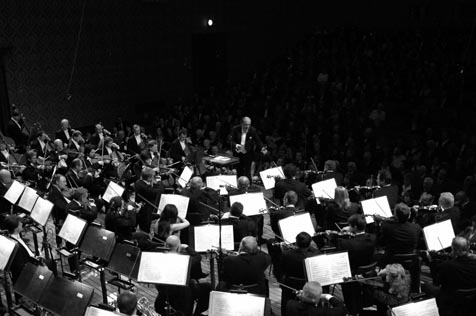The Czech Philharmonic Orchestra, presented by CAMA
At the Arlington Theatre, Thursday, February 27.

The rightfully esteemed Czech Philharmonic Orchestra showed up at the Arlington Theatre last week and served up a balanced program of two large works penned in the last century, beautifully demonstrating the great diversity and grand ambition of the confusing sprawl of 20th-century symphonic orchestral writing.
And all of this transpired through only two works-the fascinating and hard-to-pigeonhole First Symphony, circa 1942, of Bohemian composer Bohuslav MartinÅi and the ever-popular Fifth Symphony of Gustav Mahler. Mahler still had one foot in the 19th century when he wrote it in 1902, but the sweeping Fifth Symphony remains a major validation of Mahler’s status as a gateway to 20th-century musical thinking.
The orchestra, which was making its third CAMA-hosted visit to the Arlington, is welcome anytime. Founded in 1896 and with a list of conductors including composers Anton-n Dvošk and Gustav Mahler, the Czech Philharmonic sounds and feels substantial. On this night, conductor Leos Svarovsky summoned up a thick grandeur-befitting the grand canvases on the bill-but also a flexibility of color and nuance.
Those qualities merged wondrously in their sympathetic approach to the MartinÅi, which alternates chromatic murmurings with textural brushstrokes and moments of declarative melody. The pervasive influence of Stravinsky courses through the score alongside folkish motifs. Sonic masses create clenched tension across the orchestra, tension which is then defused by sighing resolutions-sometimes. MartinÅi is a composer deserving wider recognition and programming.
Mahler’s Fifth Symphony is a world unto itself, and when played with the depth and sharpness of this orchestra, it pulls us deeply into its private domain. This 75-minute adventure moves over emotional, post-Romantic, pre-Modern hill and dale. We can hear the influences of folk music, an impressionistic pictorial flair, and also the gravitas of Wagner, particularly in the hypnotically elegiac Adagietto (used so effectively in Visconti’s film Death in Venice).
Just when we’ve plumbed the depths of dark, yet elegant, despair in the fourth movement (about an hour into the piece), Mahler’s optimistic persona interjects. The last movement is all brightness and major mode hope, as if after a long, gloomy night, the curtains have been flung open to reveal a beautiful new day outside. Light pours into the room that is the emotional heart of the symphony.



